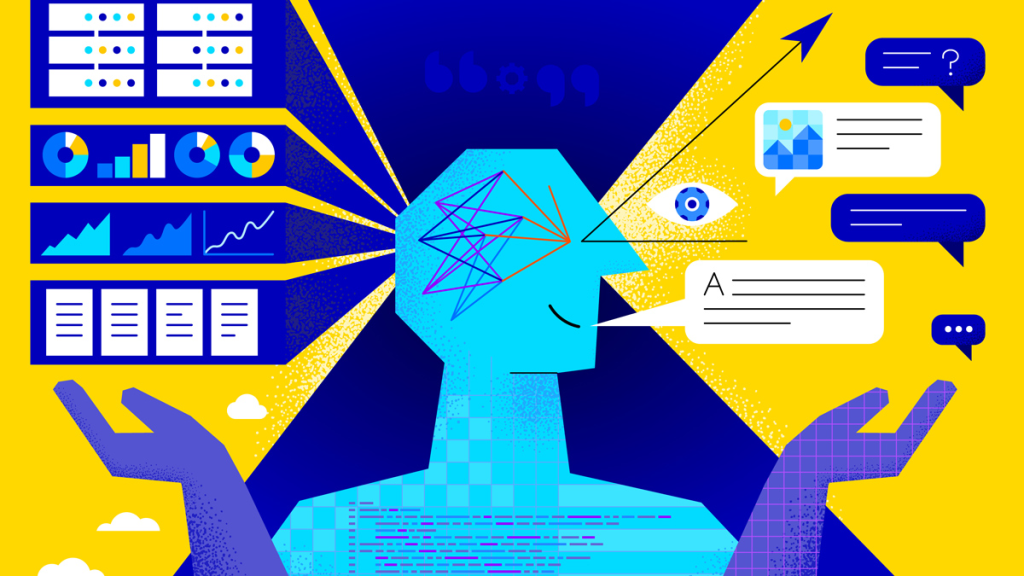
Natural Language Processing (NLP) is an exciting field that combines the power of language and artificial intelligence (AI) to enable computers to understand, interpret, and generate human language. It encompasses a wide range of techniques, algorithms, and models that facilitate the processing and analysis of textual data.
NLP has seen significant progress and gained attention due to advancements in AI, machine learning, and deep learning. It has opened up numerous possibilities and applications across various domains, showcasing the power of language and AI working together. Here are some key aspects that demonstrate their potential:
- Language Understanding: NLP enables computers to comprehend and interpret human language. Through techniques such as text parsing, semantic analysis, and syntax recognition, AI systems can extract information, identify relationships, and derive context from text.
- Language Generation: NLP allows AI models to generate human-like language based on given prompts or contexts. This capability is employed in chatbots, virtual assistants, and automated content generation systems to produce coherent and contextually relevant responses or written content.
- Information Extraction: NLP techniques facilitate the extraction of structured information from unstructured text. Methods like named entity recognition, part-of-speech tagging, and relationship extraction help computers identify and categorize entities, attributes, and their associations in text.
- Sentiment Analysis: NLP enables computers to understand and classify the sentiment expressed in text as positive, negative, or neutral. This is useful for analyzing customer feedback, social media sentiment, and brand reputation monitoring.
- Machine Translation: NLP powers machine translation systems that automatically translate text from one language to another. By leveraging AI models and language-specific datasets, computers can bridge language barriers and facilitate global communication.
- Question Answering: NLP techniques enable computers to comprehend questions in natural language and provide accurate answers. Question-answering systems use these techniques to process queries and retrieve relevant information from large amounts of text data.
- Text Summarization: NLP algorithms can distill the essential information from lengthy texts and generate concise summaries. This aids in quickly understanding the main points of news articles, research papers, and other lengthy documents.
- Conversational Agents: NLP empowers the development of conversational agents like chatbots or virtual assistants. These AI systems engage in human-like conversations, understanding user intents and responding with relevant and context-aware information.
- Text Classification: NLP enables the categorization of text into predefined categories or topics. This is useful for tasks such as spam detection, sentiment analysis, content moderation, and automated content organization.
- Speech Recognition and Synthesis: NLP techniques are employed in speech recognition systems to convert spoken language into written text and in text-to-speech systems to generate synthesized speech. These applications have implications for voice assistants, accessibility, and audio content generation.
The power of language and AI in NLP lies in their ability to bridge the gap between human language and machine understanding. By leveraging AI algorithms, machine learning models, and vast amounts of textual data, NLP enables computers to process, understand, and generate language, opening doors to enhanced communication, automation, knowledge extraction, and intelligent applications across diverse industries.
The Power of Language and AI

The combination of language and AI holds tremendous potential to revolutionize our interactions with technology, process information more effectively, and tackle complex problems. The synergistic power of language and AI can be seen in several key areas:
- Enhanced Communication and Understanding: Language serves as the primary medium of human communication. With AI-powered language models and NLP techniques, computers can better comprehend and interpret human language, facilitating more natural and efficient human-computer interactions. This improved communication enables technology to be more accessible and intuitive for users.
- Automation and Efficiency: AI technologies can rapidly analyze and process vast amounts of textual data. Leveraging language processing capabilities, AI systems can automate tasks that previously required human intervention. This includes activities such as document analysis, data extraction, customer support, and content generation. The power of language and AI can significantly boost efficiency and productivity across various industries.
- Personalization and Recommendations: AI-driven language models can analyze user preferences, behavior, and historical data to offer personalized recommendations and suggestions. This applies to areas such as e-commerce, content platforms, and digital assistants. By understanding user intent and context, AI systems can deliver tailored experiences, enhancing customer satisfaction and engagement.
- Insights and Decision-making: AI-powered language models excel at extracting valuable insights and patterns from extensive textual data. By analyzing documents, social media posts, customer feedback, and other text-based sources, AI systems can generate meaningful insights that aid in decision-making, market analysis, and trend identification. This empowers organizations to make data-driven decisions with a deeper understanding of language-based information.
- Accessibility and Inclusion: Language and AI have the potential to improve accessibility for individuals with disabilities. AI technologies, such as speech recognition, text-to-speech, and natural language interfaces, enable people with visual or hearing impairments to effectively interact with technology. AI-powered language translation can also bridge language barriers, fostering inclusivity and global communication.
- Creativity and Content Generation: Language models trained with AI techniques can generate human-like text, including creative writing, poetry, and storytelling. This has applications in content generation, copywriting, and assisting human writers in the creative process. AI systems can provide suggestions, generate drafts, and help refine ideas, expanding creative possibilities for individuals and organizations.
- Knowledge Sharing and Education: AI-powered language models serve as valuable tools for knowledge sharing and education. They can analyze and synthesize vast amounts of information, providing comprehensive answers to questions, explanations, and learning materials. AI-powered virtual tutors and language-based educational platforms offer personalized learning experiences, adapting to the individual needs and progress of learners.
- Ethical Considerations: It is crucial to address ethical considerations related to language and AI. Language models trained on extensive datasets can inadvertently inherit biases present in the data, potentially leading to biased or discriminatory outputs. Ensuring fairness, transparency, and responsible use of language-based AI is essential to mitigate potential harm and promote ethical practices.
In conclusion, the power of language and AI holds transformative potential across various domains. By harnessing AI’s capabilities to process and understand human language, we can enhance communication, automate tasks, gain valuable insights, and create more personalized and inclusive experiences. Ongoing advancements in AI and NLP continue to unlock new possibilities, fueling innovation and shaping the future of technology.
The Power of Natural Language Processing

Natural Language Processing (NLP) possesses significant power due to its ability to leverage artificial intelligence to understand, process, and generate human language. NLP techniques and algorithms enable computers to comprehend text, extract information, classify content, and engage in meaningful conversations. With applications such as sentiment analysis, language translation, question answering, and text summarization, NLP bridges the gap between human communication and machine understanding. This transformative technology has far-reaching implications, enhancing communication, automation, knowledge extraction, and user experiences across various industries.
What NLP Can Do?
Natural Language Processing (NLP) offers a wide array of capabilities that empower computers to understand and interact with human language. It encompasses various tasks such as text understanding, sentiment analysis, language translation, text summarization, named entity recognition, question answering, chatbots, text classification, information extraction, and speech recognition/synthesis. NLP enables machines to comprehend, process, and generate human language, leading to diverse applications in communication, automation, information retrieval, and intelligent systems. With continuous advancements, NLP is constantly evolving, reshaping our interactions and experiences with language-based technologies.
GPT-3
GPT-3, short for Generative Pre-trained Transformer 3, is an advanced language model developed by OpenAI. It belongs to the GPT series, which stands for “Generative Pre-trained Transformer.” GPT-3 is the latest iteration of this series and represents a significant breakthrough in natural language processing.
Built on the Transformer architecture, GPT-3 is a deep learning model that utilizes self-attention mechanisms to process and understand text. It has been trained on a large corpus of unlabeled text data from the internet, allowing it to learn patterns, grammar, and semantic relationships in language.
With an impressive parameter count of 175 billion, GPT-3 is currently one of the largest and most powerful language models available. It demonstrates exceptional performance in various language tasks, including text generation, translation, question answering, and text completion. GPT-3 can generate coherent and contextually relevant responses based on given prompts or queries, showcasing its strong natural language understanding and generation capabilities.
One notable feature of GPT-3 is its ability to perform zero-shot and few-shot learning. This means it can generalize to new tasks and exhibit reasonable performance even with minimal training examples or explicit instructions.
GPT-3 has gained significant attention due to its versatility, scalability, and potential applications across different domains. It shows promise in areas such as content generation, language translation, virtual assistants, chatbots, and creative writing.
However, it’s important to recognize that GPT-3, like other language models, has limitations. It can sometimes produce inaccurate or biased responses, and its output may be sensitive to input phrasing or context. Responsible usage and ethical considerations are crucial when working with GPT-3 or any language model to avoid potential issues like misinformation.
In summary, GPT-3 represents a significant advancement in language models, highlighting the power and potential of large-scale pre-training and fine-tuning for various natural language processing tasks.
A Language-Based AI Research Assistant

A language-based AI research assistant is an intelligent tool designed to support researchers in their work by utilizing natural language processing and artificial intelligence techniques. This research assistant leverages advanced algorithms and models to understand, analyze, and generate text-based information.
The primary objective of a language-based AI research assistant is to assist researchers in various aspects of their work, including information retrieval, literature review, data analysis, and knowledge synthesis. It aids in exploring research papers, extracting relevant information, identifying key concepts, and providing summaries or insights.
Key functionalities of a language-based AI research assistant include:
- Information Retrieval: The research assistant can efficiently search and retrieve relevant research articles, papers, or documents based on specific topics or keywords, saving researchers time and effort.
- Literature Review: It assists researchers in conducting comprehensive literature reviews by analyzing a wide range of research articles, identifying related work, and summarizing key findings or trends in a particular field.
- Data Analysis: The research assistant aids in analyzing and extracting insights from research data, such as performing statistical analysis, identifying patterns, or generating visualizations.
- Knowledge Synthesis: It helps researchers synthesize information from multiple sources, integrating different perspectives, and generating comprehensive summaries or reports on specific research topics.
- Question Answering: The research assistant can answer research-related questions by retrieving information from various sources or databases, providing quick access to relevant knowledge.
- Citation and Reference Management: It supports researchers in managing citations and references, including generating citations in various citation styles or organizing bibliographic information.
- Collaboration and Writing Support: The research assistant facilitates collaboration by assisting in co-authoring, suggesting improvements in writing style or grammar, and providing guidance in structuring research papers or reports.
- Domain-Specific Assistance: Depending on the research field, the AI assistant can be customized to provide specialized support, such as medical research, scientific experiments, or social sciences.
A language-based AI research assistant aims to augment researchers’ capabilities, increase productivity, and provide valuable insights in their work. It harnesses the power of natural language processing, machine learning, and knowledge representation to streamline research processes and assist researchers in efficiently navigating vast amounts of information.
Language-Based AI Tools Are Here to Stay

Language-based AI tools have become an integral part of our technological landscape and are set to have a lasting impact. With advancements in natural language processing and machine learning, these tools have revolutionized the way we interact with language and process textual data.
From chatbots and virtual assistants to language translation, sentiment analysis, and content generation, language-based AI tools offer a wide range of applications across various industries. They automate tasks, enhance customer experiences, extract valuable insights from large volumes of text, and enable personalized communication at scale.
Continuous research and development efforts contribute to the ongoing improvement and sophistication of language-based AI tools. As technology advances, these tools are becoming more accurate and capable of understanding and generating human language.
However, challenges remain, including ethical considerations, bias mitigation, and privacy concerns. Organizations are actively working towards addressing these challenges and ensuring responsible and ethical use of language-based AI tools.
Given the growing need for efficient language processing and the increasing volumes of textual data, the demand for language-based AI tools will only continue to rise. They have become indispensable tools for businesses and individuals, streamlining operations, boosting productivity, and transforming communication and information processing.
In summary, language-based AI tools have firmly established themselves in our technological landscape and are expected to have a lasting presence. Their transformative capabilities and ongoing advancements make them a vital component of our AI-driven world.
Thanks,






Leave a Reply
You must be logged in to post a comment.